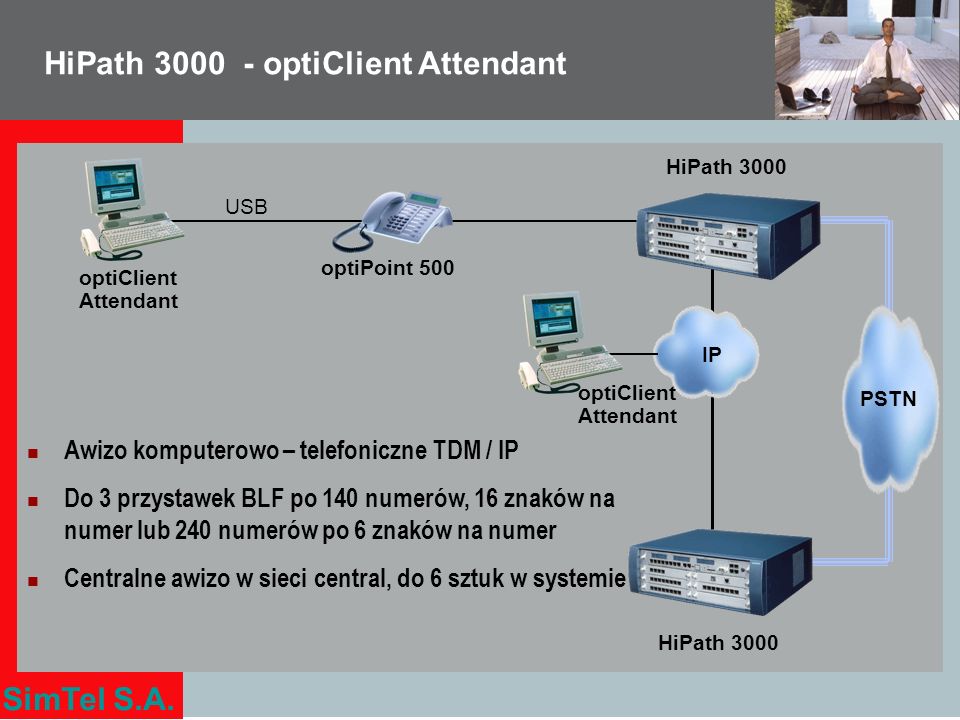Hipath Opticlient Attendant
Posted : adminOn 5/22/2018The PC Attendant Console for HiPath 2000/3000/5000 systems optiClient Attendant V8 optiClient Attendant is the PC attendant console for the HiPath 2000/3000/5000 IP communication platforms. It can be connected to the HiPath 2000, 3800, 35xx, 33xx and 5000CS models. HiPath 3000 optiClient Attendant V8 PC call attendant for HiPath 3000 optiClient Attendant is the PC call attendant for the HiPath 3000 communication system. Depending on the model, up to 6 optiClient Attendants can be connected to each communication system. All the functions of an attendant telephone are simulated on the graphical.

Contents • • • • • • • • • • • • • • • • • • • • • • • • • • Overview optiClient 130 S is compatible with (IETF) standards for SIP. The product is ideal for operation in conjunction with Siemens HiPath systems and supports their advanced features (line keys, for example) • V1.0 • V6.0 • V6.0 • version 2.x Releases are not currently planned for other platforms. Telephone software distribution and configuration is performed with the (Deployment Service) tool. DLS supports plug&play operation. Note: Due to lack of support on the switches, only the following features have been released for HiPath 2000 / 3000 / 5000 systems: Accept incoming call, Make outgoing call, Consultation Description of Features The optiClient 130 S V4 is modular in structure and consists of a system of function elements that guarantee maximum flexibility and alignment with the requirements of the user.

These elements include: • Main bar – The main bar is the central element that, together with the modules listed below, determines the features available and how they are displayed for the user. • Interface modules – For implementing the extensive function range available in windows and dialog boxes, including the phone module for telephony features, the Audio Manager for operating audio telephones, call lists and address books. • Provider modules – The communication system or service provider connected to optiClient 130 can be set here. • Manager modules – These background modules perform communication control tasks and include the Keyboard Manager and the ScreenSaver Manager. • Video modules – The actual video image and the external partner or both conference partners are displayed here. User interface The optiClient 130 user interface consists of a main bar (system bar) that contains a number of associated dialogs for selecting the individual functions and settings and identifying the ringing state. User interface features: • The optiClient main bar can be positioned at random on the desktop.
• Open windows can be dragged from the main bar and positioned at random on the screen. Extended keypad This option lets the user add programmable keys to the keypad. The maximum number of columns, the number of function keys per column and how the function keys are programmed depend both on the preferred settings and the HiPath provider connected. The application's individual modules can be dragged from the main bar and randomly positioned on the screen. This means that frequently used functions, such as speed-dial keys, can be anchored at random on the screen. Delete Ntldr Using Batch File.
Line keys optiClient 130 S version 4 provides a number of line keys for the user. This makes it suitable for use as a executive/secretary device. OptiClient 130 S V4 also features a module known as easyCom (see screenshot under Overview) that is based on a straightforward and intuitive principle. Users are in the center of the 'communication circle' and communicate by moving their communication partners from the address book to the communication circle via drag&drop with the mouse. • New and modern user interface that can be customized to suit the user's requirements • Enhanced telephony functions, such as the extended keypad • Ideal solution for mobile workers – the user always keeps the same internal station number, irrespective of location • Individual access rights and other parameters remain, such as, the initiated call forwarding and do-not-disturb features • Use of multiple LDAP directories is supported and improves daily workflow through the use of corporate address books, Outlook Contacts, etc.